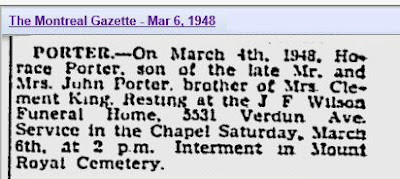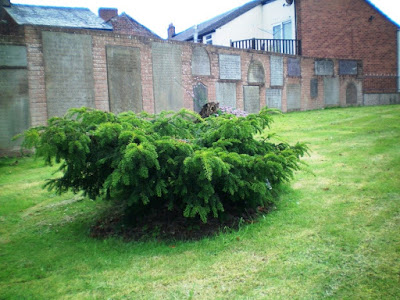Your beloved ancestor dies. A plot is purchased and the funeral arrangements made. After a mournful service in the church the loved one is interred in the family plot and soon the headstone, chiseled with his name and dates and perhaps a sentiment or verse from the Bible, will be placed to mark the place where he lies. May he rest in peace.
.... or not!
I found a Find-a-Grave memorial for a cousin, George King, died in 1888 at 19 years of age and buried in Section C of the Cheltenham Cemetery in Port Adelaide, South Australia. This is his obituary...
Like I hopefully do with all my ancestor memorials, I requested a photo of the gravestone. Imagine my surprise when I received this reply:
Problem reported.. specifically:
Unfortunately George's gravesite has now been repurchased by another family. His remains have been moved to a corner of the site, but all that remains on the site is the headstone for the new interment, Anthony Ciantor. I have taken a photo and added it to Anthony's memorial # 100220191Anthony Ciantor died in 2008.
I am now checking George's other family members to see if they have been put in a corner also, and have written a message to the Cemetery Authority to ask about this practice.
No reply as yet.
Update: From the Adelaide Cemeteries Authority
The tenure of an Interment Right, formally known as a Lease, Grant or Licence varies from cemetery to cemetery. The Adelaide Cemeteries Authority offers an initial tenure period of 50 or 99 years. Interment Rights can be renewed at any time during the tenure period. The minimum renewal period is 5 years.
If the Interment Right Holder or other interested party chooses not to renew, or a minimum period of 2 years has elapsed since notice was given and the interment right has not been renewed, ownership of the sites reverts to the Adelaide Cemeteries Authority. At this point in time, the site may be re-used in accordance with the Burial and Cremation Act 2013.Check with your ancestor's cemetery to see if the rules say you buy the plot in perpetuity, or lease the plot for a set time with options to renew.
Another strange occurrence was with my 2x great uncle Horace Porter. That's the poor guy who was hit on the head with a brick during a tramway strike and spent the next 45 years in an insane asylum. When he died this notice was placed in the Montreal Gazette:
I contacted the Mount Royal Cemetery requesting a burial location, and I received this reply:
Name: Horace Melvin Porter
He was removed from the cemetery on May 20th, 1948 and his final disposition is unknown.
When I later got a photo of his parents' gravestone, I see Horace was (possibly) buried with them in the family plot in Kirkdale, Quebec. His sister, my great grandmother, who visited him every week for 45 years would have seen to that.
Porters, Kirkdale Cemetery, Quebec
My 2x great grandfather John Seale's first wife, Sarah died in 1834 and was buried in the Milton Family Burial Ground (Pittsburgh, Ontario) located by the river on the Milton property, right next door to the Seale's lot. John's son Henry David, who died in 1859 at 3 years 8 months was also buried there, as were his in-laws the Hunters. Cataraqui Cemetery opened in 1850 and in 1874 the remains of Sarah, Henry and the Hunters were moved there to a newly purchased family plot. Later, in 1958, John's son Charles was also moved to Cataraqui from Milton.
Seale and Hunter Memorial, Cataraqui Cemetery
Some of my Lancashire ancestors are buried in the c1236 cemetery of St James Church in Stalmine. You will not find the gravestones walking around the cemetery, because in 1973 they were removed, cleaned and embedded in a new wall to make it easier to keep the cemetery neat. There was estimated that over 3000 people were buried in this small cemetery just between 1583 and 1724, and even more until closing to burials around 1899. In the year 2000 the Church of England offered parishes a yew tree, cuttings from a 2000 year old yew at St Mary's on Hampshire's Hayling Island. St James accepted.
Info and photo sent to me by the clerk of St James, Stalmine.
Then comes Dora. Dora Porter was my 2x great aunt and the sister of Horace. Dora died in 1943 in Philadelphia, in a home for the indigent. She had beloved parents that had died more than 20 years before. Dora had a loving husband that died in 1936 and was buried in Mt Peace Cemetery. None of this was noted on her death certificate.
Father... unknown. Mother... unknown. Husband... unknown.
The informants signature is that of a city desk clerk. Dora was aged 72 and they wrote her cause of death as hemiplegia, generalized arteriosclerosis due to senility.
Place of burial: Anatomical Board??
¹From Pennsylvania Cadaver Receiving Books for 1943
Her body was given to medical research. I would think that if she was senile and didn't know her parents or husband's name, she was surely not able to sign for this? Was there even a burial afterwards? Was there anything left to bury? Those were my first questions.
Researching further I discovered that according to the Pennsylvania Anatomy Act of 1883 (to deter grave robbing) the state was given the right to use unclaimed bodies for medical research. When Dora died she did have 7 siblings still living, but perhaps due to her senility was unable to tell anyone.
Anatomical Board Cadaver Receiving Books may be found in city archives with Department of Health records.
If you have insights into any of these situations, or if you have an ancestor who was not left buried - we would love to hear about it.
May they all rest in peace!
Relevant Links
History of the Anatomy Act of Pennsylvania, pdf
¹Source:
Pennsylvania Historical & Museum
Commission
Record Group 11, Records of the Department
of Health
Series 11.45, Cadaver Receiving Books, 1901-1965. 
















No comments:
Post a Comment
Leave me a note to tell me you were here! Thanks for visiting.